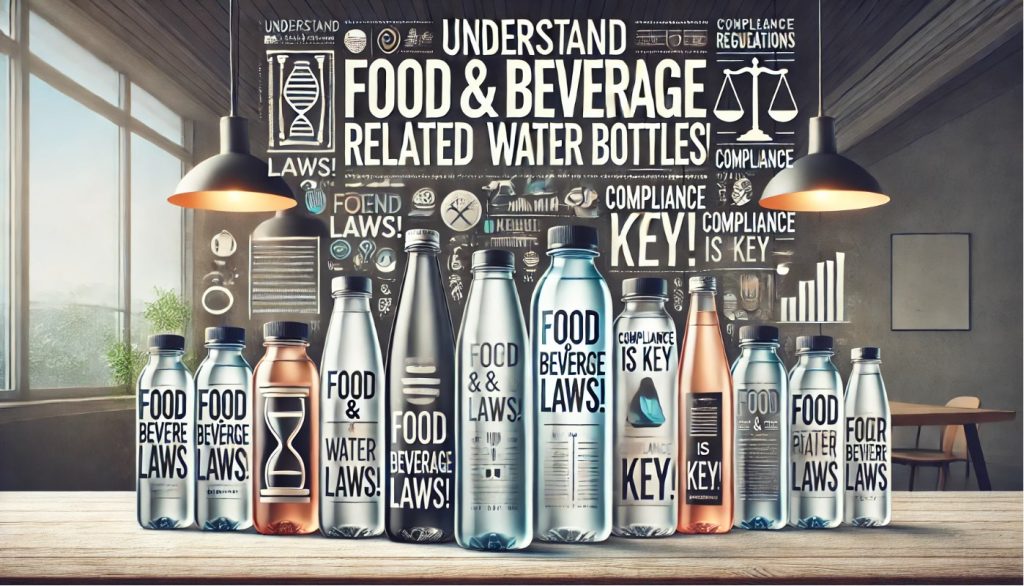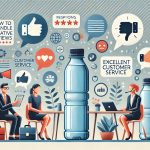Water bottles are considered consumer goods that fall under various food and beverage laws due to their direct contact with drinking water or beverages. As the global demand for reusable, eco-friendly water bottles increases, businesses must navigate a complex legal landscape to ensure that their products comply with food safety, labeling, and environmental regulations. These laws are designed to protect consumers from potential harm and ensure that the products they purchase meet health, safety, and quality standards.
The regulatory framework for water bottles involves multiple agencies and standards across different regions, including food contact material regulations, recycling laws, and sustainability initiatives. Understanding the intricacies of these laws is critical for businesses involved in the manufacturing, distribution, and sale of water bottles.
Food Contact Material Regulations
Defining Food Contact Materials
Food contact materials (FCMs) refer to any materials that are intended to come into contact with food or beverages during production, packaging, storage, or transportation. Water bottles are classified as FCMs, as they directly interact with water or other liquids that are consumed by humans. As such, water bottle manufacturers must ensure that their products meet strict regulatory standards to ensure consumer safety.
Regulatory Agencies Governing FCMs
Several regulatory bodies oversee the safety of food contact materials, ensuring that they do not release harmful substances into food or beverages. In the U.S., the Food and Drug Administration (FDA) is responsible for regulating FCMs, including water bottles, while in the European Union, the European Food Safety Authority (EFSA) plays a similar role. Each region has specific laws and guidelines that manufacturers must adhere to when producing water bottles.
U.S. Food and Drug Administration (FDA)
The FDA regulates materials that come into direct contact with food and beverages under the Federal Food, Drug, and Cosmetic Act. For water bottles, the FDA sets standards for the materials used, such as plastics, metals, and glass, to ensure they are safe for use in consumer products. Manufacturers must demonstrate that the materials used in water bottles are not toxic or harmful and do not leach dangerous substances like Bisphenol A (BPA) into the liquid.
For plastic water bottles, the FDA requires manufacturers to conduct tests to ensure that chemicals from the plastic do not migrate into the contents of the bottle in harmful amounts. Water bottles made from materials such as stainless steel, glass, or aluminum must also meet safety standards to ensure that they do not introduce toxic substances or contaminants.
European Food Safety Authority (EFSA)
In the European Union, EFSA regulates food contact materials under Regulation (EC) No 1935/2004. This regulation ensures that all FCMs, including water bottles, are manufactured in a way that does not pose a risk to human health. EFSA provides scientific opinions on the safety of food contact materials and establishes guidelines for their use, including specific migration limits (SMLs) for substances that could migrate from the material into food or beverages.
Water bottle manufacturers in the EU must comply with EFSA’s safety standards and demonstrate that their products are made from materials that are both safe and sustainable. Products like water bottles must be clearly marked to show compliance with these regulations, and manufacturers must provide evidence of their safety testing.
Material Safety Standards for Water Bottles
Water bottles are often made from a variety of materials, including plastic, stainless steel, glass, and aluminum. Each material has its own set of regulations to ensure that it is safe for food contact. Some materials, such as certain plastics, are more heavily regulated due to concerns about chemicals leaching into beverages.
Plastics and BPA Concerns
One of the primary concerns in the water bottle industry is the use of plastics, particularly those that contain Bisphenol A (BPA). BPA is a chemical used in the production of certain plastics, particularly polycarbonate plastics, which have been found to leach into food and beverages. Research has raised concerns about the potential health effects of BPA exposure, particularly in relation to hormone disruption and developmental issues.
In response to these concerns, many countries have implemented regulations to limit or ban the use of BPA in water bottles. For example, the FDA has banned the use of BPA in baby bottles and sippy cups, and many manufacturers now produce BPA-free water bottles to meet consumer demand for safer products. Additionally, the European Union has also banned the use of BPA in certain products and requires that manufacturers use alternative materials that do not contain this chemical.
Stainless Steel, Glass, and Aluminum Bottles
While plastic bottles have raised significant concerns regarding chemical leaching, alternatives such as stainless steel, glass, and aluminum are often seen as safer options. These materials are non-toxic, durable, and less likely to leach harmful chemicals into beverages. However, they must still comply with safety standards related to food contact materials.
For example, stainless steel water bottles must meet specific guidelines to ensure that they do not release harmful metals, such as lead or cadmium, into the water. Glass water bottles must meet safety standards related to breakage resistance and the absence of harmful additives during production. Aluminum bottles are often lined with coatings to prevent direct contact with the liquid, and the coatings must meet safety standards to prevent chemical migration.
Labeling Requirements for Water Bottles
Labeling Standards for Food Contact Materials
Clear and accurate labeling is essential for ensuring that consumers are informed about the materials used in their water bottles and the potential risks associated with those materials. In the U.S. and the EU, labeling regulations for water bottles require manufacturers to disclose certain information about the materials used and their safety.
In the U.S., the FDA does not mandate specific labeling requirements for most food contact materials, but it does require that manufacturers include certain information to ensure consumer safety. This includes labeling to indicate that the product is BPA-free if the bottle is made from plastic and does not contain any harmful chemicals.
In the EU, food contact materials must be labeled in accordance with Regulation (EC) No 1935/2004. This regulation requires that manufacturers provide clear, concise information about the safety of the materials used in water bottles. The label must indicate whether the product complies with European safety standards and may include certifications or symbols to show that the product is safe for food contact.
Sustainability Labels and Certifications
With growing consumer demand for eco-friendly products, many water bottle manufacturers seek sustainability certifications or labels to demonstrate their commitment to environmentally-friendly practices. These certifications may include the following:
- Recyclability Labels: Many water bottles are designed to be recyclable, and including a recycling symbol or other certification on the label can inform consumers about the product’s environmental impact.
- BPA-Free Certifications: BPA-free certifications have become a key selling point for water bottles, particularly those made from plastic. These certifications provide reassurance to customers that the product is free from harmful chemicals.
- Eco-Friendly and Organic Certifications: Some manufacturers may pursue certifications like the Green Seal or Fair Trade Certified to demonstrate their commitment to sustainable materials and ethical practices in production.
By clearly labeling their products with these certifications, water bottle companies can differentiate themselves in the market and appeal to environmentally-conscious consumers.
Environmental Regulations and Sustainability
Plastic Waste and Recycling Initiatives
The issue of plastic waste is one of the most pressing environmental concerns related to water bottles. Governments around the world have implemented policies to curb plastic pollution, and these regulations can impact how water bottles are manufactured, packaged, and sold.
Plastic Bans and Regulations
Several countries and regions have enacted bans or restrictions on single-use plastic products, including water bottles. For example, the European Union introduced the Single-Use Plastics Directive, which bans the sale of certain single-use plastic products, including plastic bottles, by 2025. The directive also includes measures to reduce plastic waste, such as requiring producers to contribute to the collection and recycling of plastic bottles.
In the U.S., some states and cities have implemented bans on single-use plastic bottles or have imposed taxes on plastic products to encourage consumers to switch to reusable alternatives. The rising pressure to reduce plastic waste has led many water bottle manufacturers to focus on producing sustainable, reusable bottles made from materials such as stainless steel, glass, and recycled plastics.
Extended Producer Responsibility (EPR)
Extended Producer Responsibility (EPR) is a regulatory approach that holds manufacturers accountable for the entire lifecycle of their products, including disposal and recycling. Some countries, particularly in Europe, have implemented EPR schemes for plastic products, including water bottles. Under these programs, manufacturers are required to take responsibility for collecting and recycling their products once they are used.
EPR regulations encourage manufacturers to adopt sustainable packaging practices and design products that are easier to recycle. Many water bottle companies are already aligning their operations with EPR initiatives by producing recyclable bottles or implementing take-back programs for used bottles.
Eco-Friendly Materials and Packaging
Water bottle manufacturers are increasingly focusing on sustainable materials and eco-friendly packaging to meet consumer demand for environmentally conscious products. The use of biodegradable plastics, recycled materials, and reusable packaging is becoming more common as companies seek to reduce their environmental footprint.
- Recycled Materials: Many water bottle companies are incorporating recycled plastics into their products to reduce their reliance on virgin plastic. This not only helps decrease the amount of waste in landfills but also lowers the carbon footprint associated with producing new plastic.
- Biodegradable Plastics: Some companies are turning to biodegradable plastics or plant-based materials as alternatives to traditional plastic. These materials decompose more quickly and have less impact on the environment.
- Minimal Packaging: To reduce waste, some water bottle brands are adopting minimal packaging strategies, using recyclable paper or cardboard packaging instead of plastic wrapping.
Adhering to environmental regulations and consumer preferences for eco-friendly products is increasingly important in the water bottle market. Businesses that focus on sustainability can not only comply with regulations but also enhance their brand image and appeal to environmentally-conscious customers.
Health and Safety Regulations for Water Bottles
Toxicity and Chemical Migration
Water bottles must meet strict health and safety regulations to ensure that they do not leach harmful chemicals into beverages. This is especially important for plastic bottles, which can release toxins like BPA or phthalates when exposed to heat or light.
In response to consumer concerns, many countries, including the U.S. and the EU, have introduced regulations to limit the migration of harmful substances from water bottle materials into beverages. The FDA and EFSA set specific migration limits for substances that could potentially leach into food or beverages. Manufacturers must ensure that their products meet these limits by conducting safety tests on materials used in water bottle production.
For bottles made from stainless steel, glass, or other materials, manufacturers must ensure that they are free from harmful metals or chemicals that could potentially contaminate the liquid inside. Additionally, water bottle caps, seals, and other components must be manufactured using non-toxic materials to ensure the overall safety of the product.
Water Bottle Labels and Safety Information
Water bottles are often required to include safety information on their labels. This may include details on the safe usage and care of the product, as well as warnings related to potential risks, such as using the bottle with hot liquids or leaving the bottle in direct sunlight for extended periods.
Some regulations may also require specific safety symbols or certifications on the label to indicate that the water bottle meets health and safety standards. For example, a water bottle made from food-grade stainless steel may be required to display certifications that confirm it meets material safety standards.
International Standards and Compliance
Navigating Global Regulatory Differences
When exporting water bottles to international markets, businesses must understand the regulatory differences between countries and regions. Each country has its own set of food safety, labeling, and environmental regulations that water bottle manufacturers must comply with.
For example, while BPA-free labeling may be mandatory in some regions like North America and Europe, other markets may not have such stringent regulations. Similarly, regulations around plastic packaging, recycling, and sustainability vary widely depending on the country.
To successfully navigate these differences, businesses should partner with legal experts or regulatory consultants who are familiar with the laws in the markets they wish to enter. Understanding local requirements and complying with international standards ensures that water bottles can be sold without legal complications or delays.
Conclusion
The food and beverage laws related to water bottles are complex and multifaceted, covering everything from material safety to labeling, packaging, and environmental regulations. Water bottle businesses must navigate these laws carefully to ensure that their products are safe, compliant, and appealing to environmentally-conscious consumers. By understanding the regulatory landscape and adapting to local and international requirements, water bottle manufacturers can protect their customers and their brand while staying competitive in a rapidly evolving market.







